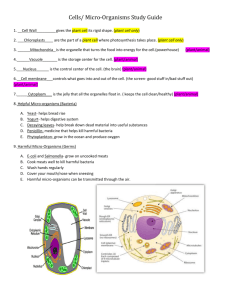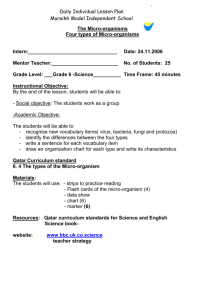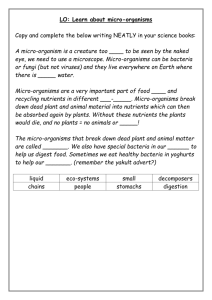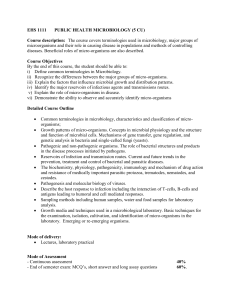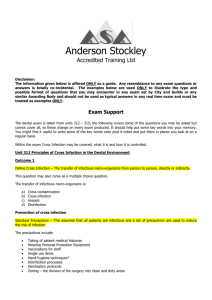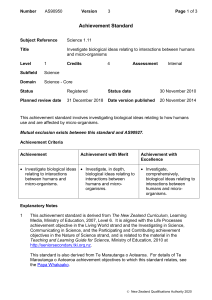Understanding pasteurisation and sterilisation processes
advertisement
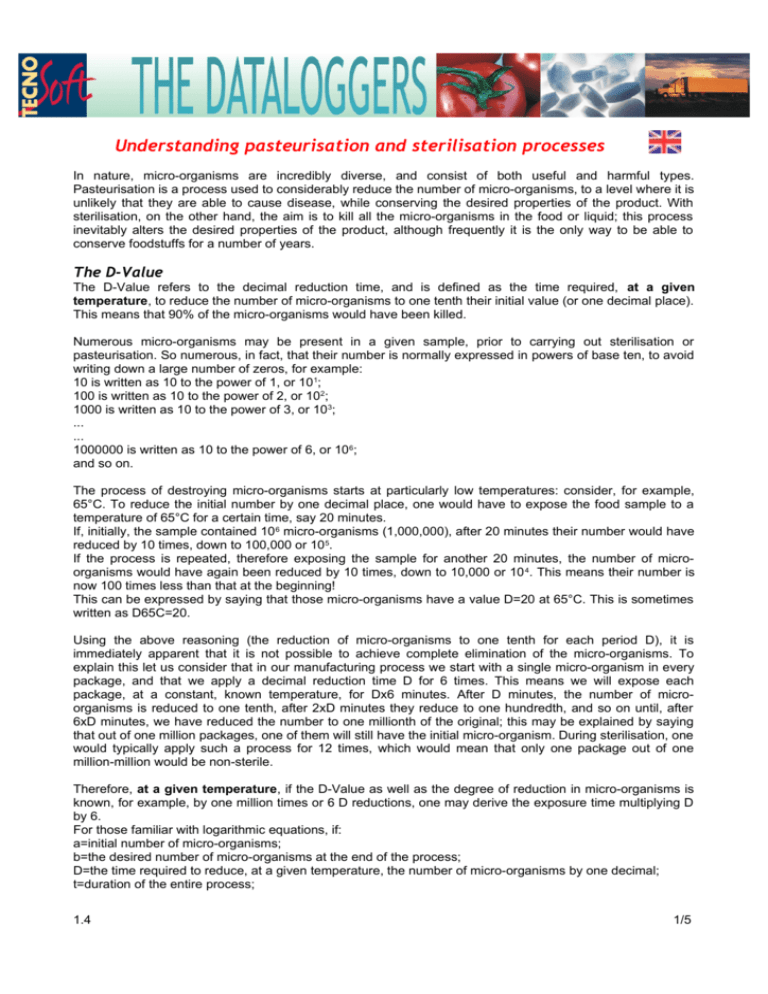
Understanding pasteurisation and sterilisation processes In nature, micro-organisms are incredibly diverse, and consist of both useful and harmful types. Pasteurisation is a process used to considerably reduce the number of micro-organisms, to a level where it is unlikely that they are able to cause disease, while conserving the desired properties of the product. With sterilisation, on the other hand, the aim is to kill all the micro-organisms in the food or liquid; this process inevitably alters the desired properties of the product, although frequently it is the only way to be able to conserve foodstuffs for a number of years. The D-Value The D-Value refers to the decimal reduction time, and is defined as the time required, at a given temperature, to reduce the number of micro-organisms to one tenth their initial value (or one decimal place). This means that 90% of the micro-organisms would have been killed. Numerous micro-organisms may be present in a given sample, prior to carrying out sterilisation or pasteurisation. So numerous, in fact, that their number is normally expressed in powers of base ten, to avoid writing down a large number of zeros, for example: 10 is written as 10 to the power of 1, or 101; 100 is written as 10 to the power of 2, or 102; 1000 is written as 10 to the power of 3, or 10 3; ... ... 1000000 is written as 10 to the power of 6, or 10 6; and so on. The process of destroying micro-organisms starts at particularly low temperatures: consider, for example, 65°C. To reduce the initial number by one decimal place, one would have to expose the food sample to a temperature of 65°C for a certain time, say 20 minutes. If, initially, the sample contained 10 6 micro-organisms (1,000,000), after 20 minutes their number would have reduced by 10 times, down to 100,000 or 105. If the process is repeated, therefore exposing the sample for another 20 minutes, the number of microorganisms would have again been reduced by 10 times, down to 10,000 or 10 4. This means their number is now 100 times less than that at the beginning! This can be expressed by saying that those micro-organisms have a value D=20 at 65°C. This is sometimes written as D65C=20. Using the above reasoning (the reduction of micro-organisms to one tenth for each period D), it is immediately apparent that it is not possible to achieve complete elimination of the micro-organisms. To explain this let us consider that in our manufacturing process we start with a single micro-organism in every package, and that we apply a decimal reduction time D for 6 times. This means we will expose each package, at a constant, known temperature, for Dx6 minutes. After D minutes, the number of microorganisms is reduced to one tenth, after 2xD minutes they reduce to one hundredth, and so on until, after 6xD minutes, we have reduced the number to one millionth of the original; this may be explained by saying that out of one million packages, one of them will still have the initial micro-organism. During sterilisation, one would typically apply such a process for 12 times, which would mean that only one package out of one million-million would be non-sterile. Therefore, at a given temperature, if the D-Value as well as the degree of reduction in micro-organisms is known, for example, by one million times or 6 D reductions, one may derive the exposure time multiplying D by 6. For those familiar with logarithmic equations, if: a=initial number of micro-organisms; b=the desired number of micro-organisms at the end of the process; D=the time required to reduce, at a given temperature, the number of micro-organisms by one decimal; t=duration of the entire process; 1.4 1/5 then: t=D(log a – log b); where (log a – log b) is the number of decimal reductions. To complicate matters a bit further, we introduce the Z-Value. The Z-Value One may wonder, what would happen if the temperature is increased? In this case, the number of microorganisms destroyed per minute will increase. It is possible to determine, experimentally, the increase in temperature required to reduce the value of D by a factor of 10 (in our example, from 20 minutes to just 2 minutes): this increase in temperature is represented by the Z-Value and is expressed in °C. The Z-Value is therefore the temperature change that will bring about a 10-fold change in the D-Value. The Z-Value is measured in °C. It is important to note that by changing the temperature, the thermal destruction of micro-organisms is greatly altered. The F or P values. The sterilisation or pasteurisation values. In general, process operators are simply interested in the following information: at what temperature and for how long should the process be carried out? In industry one would commonly ask for the F or P value at a certain temperature. In sterilisation processes we frequently encounter a specific value of F, known as F0 (F-naught). This is the number of minutes of equivalent sterilisation at 121.11°C. (This is equivalent to 250°F). If another temperature is used this is normally stated after the symbol F. For example we could have F110 or F135 and so on. In practice the F-Value is typically set at 12D values. For pasteurisation processes, technically one should refer to the P value, however F is commonly used instead. The F-Value (or P-Value) is therefore the duration (in minutes) of the entire sterilisation or pasteurisation process, at a defined temperature. In pasteurisation applications, especially for drinks, one encounters the term Pasteurisation Units – PU. One PU is defined as exposing a product at 60°C for 1 minute. In practice, such processes will not be identical to the theoretical ones: in fact the temperature will not rise immediately to the target value, it will not remain perfectly constant over time and will not drop to the ambient temperature in an instant. Consider the typical diagram shown below: 1.4 2/5 and observe how the value F0 (referred to 121.11°C) changes progressively. The process is carried out with Z=10: Date and Time °C F0 19/05/2006 13.25.50 28.38 0 19/05/2006 13.26.50 28.65 0 19/05/2006 13.27.50 26.64 0 19/05/2006 13.28.50 26.99 0 19/05/2006 13.29.51 26.72 0 19/05/2006 13.30.51 26.31 0 19/05/2006 13.31.51 26.25 0 19/05/2006 13.32.52 26.84 0 19/05/2006 13.33.52 28.5 0 19/05/2006 13.34.52 31.4 0 19/05/2006 13.35.53 35.84 0 19/05/2006 13.36.53 41.71 0 19/05/2006 13.37.54 48.64 0 19/05/2006 13.38.55 56.25 0 19/05/2006 13.39.56 63.55 0 19/05/2006 13.40.58 71.66 0 19/05/2006 13.42.00 79.96 0 19/05/2006 13.43.02 89.3 0 19/05/2006 13.44.06 97.27 0 19/05/2006 13.45.10 103.72 0.01 19/05/2006 13.46.15 109.2 0.02 19/05/2006 13.47.20 110.04 0.1 19/05/2006 13.48.26 110.35 0.18 19/05/2006 13.49.31 110.53 0.27 19/05/2006 13.50.36 110.34 0.37 19/05/2006 13.51.42 110.53 0.46 19/05/2006 13.52.47 109.95 0.55 19/05/2006 13.53.53 110.06 0.64 19/05/2006 13.54.58 110.24 0.72 19/05/2006 13.56.04 110.43 0.81 19/05/2006 13.57.09 110.39 0.91 19/05/2006 13.58.15 110.39 1 19/05/2006 13.59.20 110.01 1.09 19/05/2006 14.00.26 110.29 1.18 19/05/2006 14.01.31 110.06 1.27 19/05/2006 14.02.36 110.1 1.35 19/05/2006 14.03.42 109.96 1.44 19/05/2006 14.04.47 109.77 1.52 1.4 3/5 19/05/2006 14.05.53 99.94 1.6 19/05/2006 14.06.57 74.48 1.61 19/05/2006 14.07.59 73.81 1.61 19/05/2006 14.09.02 30.36 1.61 19/05/2006 14.10.02 30.35 1.61 19/05/2006 14.11.02 30.32 1.61 19/05/2006 14.12.03 30.25 1.61 19/05/2006 14.13.03 31.3 1.61 19/05/2006 14.14.03 30.77 1.61 19/05/2006 14.15.04 30.6 1.61 19/05/2006 14.16.04 30.4 1.61 19/05/2006 14.17.05 30.31 1.61 19/05/2006 14.18.05 30.15 02.01.0 0 As can be observed, F0 starts to change when the temperature rises to about 100°C and remains constant after this drops below 100°C. Also note that we get a value for F0 even though the process never actually reaches 121.11 °C. This is possible thanks to the effect of the Z-Value, which allows for the calculation of equivalent thermal processes. Software programs that automatically analyse data from sterilisation and pasteurisation processes require that a few parameters are set up: – The reference temperature T (in general this is 121.11°C for sterilisation and 60°C for pasteurisation) – The Z-Value (in °C, that corresponds to the change in temperature required to change the decimal reduction time by a factor of 10) which is necessary to cater for the fact that the process is not carried out at a single constant temperature. The program will automatically calculate the value for F (or P for pasteurisation) that has been defined for the temperature T. If necessary, one may also introduce a threshold value for temperature below which any contribution to the F (or P) value is ignored. One may also express the above in terms of sterilisation or pasteurisation units, since one unit is effectively one minute of exposure to a nominal temperature T. Therefore, a value of F0 = 5.5 minutes is equivalent to 5.5 sterilisation units (At 121.11°C), and 20 pasteurisation units are equivalent to exposing the product for 20 minutes at the reference temperature (normally 60°C). The reference temperature, Z-Value and the process duration parameters (if one wants to use the PU or SU) depend upon the type of micro-organisms one wants to destroy, and are published. Technical aspects of temperature monitoring Where should measurements be taken? In practice, sterilisation and pasteurisation equipment have chambers of a certain size, and the temperature distribution inside these chambers may not be uniform. One needs to map temperatures inside such spaces in order to identify critical zones and tune the process so that it is effective even in the worst case areas. One should not simply rely on the thermometer supplied with the equipment, since although this is normally accurate, its sensing point could be located in a more favourable zone of the chamber. Furthermore, the measurements should be made at the core of the product, since this area presumably reaches the desired temperature after the rest, and it is the point of interest for the process. What effect can the type of process have? The values of F or P will differ according to the environment in which the processes are carried out, mainly because the time it takes for the core of the product to rise to the desired temperature will depend upon the type of process. For example in steam sterilisation the above values, as well as the reference temperature, will not match those for hot-air or microwave processes. Microwave sterilisation, in particular, does not produce en even temperature distribution. 1.4 4/5 What type of instrument should be used? Any calibrated instrument will provide a valid measurement. This may be based upon thermocouple, thermistor or RTD sensors. If possible, use miniature data loggers that can be placed inside the product or whose probes can be inserted in the product being monitored. For on-line, or real-time monitoring, where you will be able to view the temperature profile in real time, you will need to employ miniature, wireless data loggers. These will let you view the measurements as they are acquired, rather than after the process is complete. Tecnosoft s.r.l. Via Galvani, 4, 20068, Peschiera Borromeo (Milano)- ITALY - tel +39 02 26922888 - fax +39 02 26922875 e-mail: info@tecnosoft.eu - web: www.tecnosoft.eu UNI EN ISO 9001:2008 certified for Firmware and Software development 1.4 5/5
